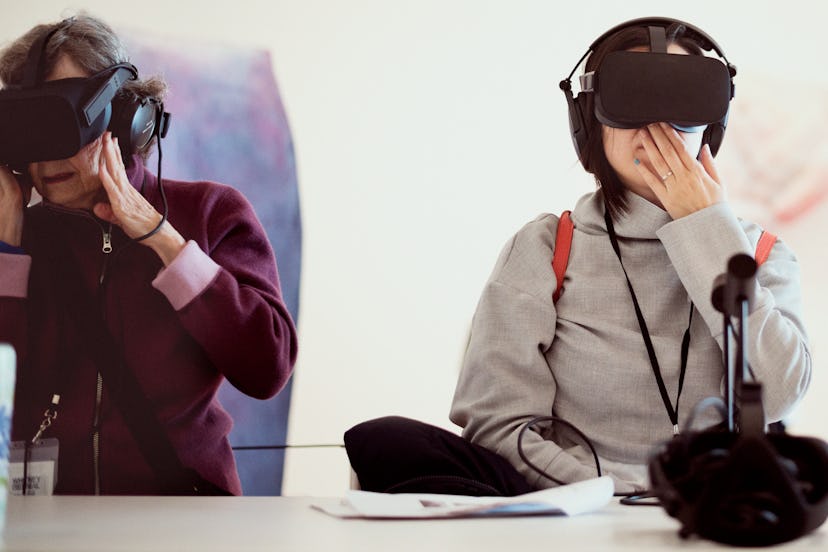“The Work Is Repellant”: All the Horrified Reactions to Jordan Wolfson’s Ultraviolent VR Art at the Whitney Biennial
It’s not all fun and games at the 2017 Whitney Biennial. Jordan Wolfson’s VR contribution is what some critics are calling “the most disturbing, horrifying artwork I have ever seen.”

On Monday morning, I arrived at the Whitney Museum eagerly anticipating several hours of immersion in the artworks that make up the 78th Whitney Biennial—the survey’s first-ever edition in the museum’s new Renzo Piano-designed, downtown building, compiled by the notably thirtysomething curators Christopher Y. Lew and Mia Locks. What I did not expect, then, was to look away into a corner while experiencing one of the survey’s major pieces, doing my best to ignore what was happening in front of me for nearly a minute and a half as I gripped a railing that a docent had instructed me to.
In other words, Real Violence, the nightmare-inducing artist Jordan Wolfson‘s VR work in the biennial, is not for the faint of heart. After putting on a VR headset and headphones, viewers are treated to a 90-second film that starts with a serene shot of the sky before quickly dropping to the pavement, where the artist himself approaches and looks directly at the viewer, picks up a baseball bat, and begins graphically beating—and then stomping on—a man in broad daylight, till the victim (actually an animatronic doll, but more than real-looking enough) was past the point of bloody pulp.
It’s all set to the tune of Hebrew prayers read by Wolfson, which have led some to believe the artist’s motivations with his provocations were political; this is, after all, in the words of the critic Jerry Saltz, “the most politically charged [biennial] in decades.” Saltz, for one, seems to be giving Wolfson the benefit of the doubt: “Maybe [Trump]’s there in the work that people will argue about: Jordan Wolfson’s ultraviolent 90-second virtual-reality film that feels like a metaphor for the unfocused furor I gleaned at Trump rallies,” he wrote in New York. Others, however, not so much. Before the show opens to the public on Friday, here are some of the less agreeable reactions to what the critic Andrew Russeth called “the most disturbing, horrifying artwork I have ever seen.”
“The work is repellant. Which—I know, I know—is the point. But at a time of actual anti-Semitic threats and actual mob violence, mining the subject for a hyperreal high feels more than lame and less than cheap. It gets you talking—but mainly about how shallow art can be.” — Ben Davis, artnet News
“It is extremely difficult to watch. I ended the piece soaking in sweat, despite knowing that his victim is an animatronic doll. Rage has fueled Wolfson’s work for years, churning away just below the surface, but here it consumes him, transforming him into a gleeful embodiment of white, male anger. If Wolfson is a newer generation’s Jeff Koons, this is his “Made in Heaven” moment—an outrageous, borderline insane overreach that many will shun even while agreeing that it solidifies his reputation. Going too far, simulating murder (as opposed to sex), Wolfson is proving that he cannot, and will not, be constrained. In, say, 20 years, I imagine the piece being revived in a tony secondary market gallery. Which is fine. But I don’t want to watch it again until then.” — Andrew Russeth, ARTnews
“Perhaps the biennial’s most tin-eared moment is the one in which it attempts to bodyshock in the most literal way: Real Violence (2017) by Jordan Wolfson … I can guess why this pantomime snuff movie is included: it’s easy for a show such as this to give the impression that all the artists have joined hands around the campfire, singing Kum-ba-yah, and it needs contrasts. I can guess how the Hebrew prayer and white victim can both complicate the reading of Wolfson’s piece and directly nod to the horrific spike in anti-semitic violence across the US since the election. I get that it’s necessary to be reminded that art is not always a moral good. That VR and videogames generate physical and moral dissonances, dissonances that expose how violence is, daily, palpably close at hand for many people, and for others just an abstraction. That men can be ghastly shitheads towards other human beings, that a certain type of man can beat another on the street and not immediately get shot by a cop. I get that Wolfson is most effective as an artist when needling taboos in ways that are almost sociopathically slippery. But in Real Violence his provocation flatlines as an expensive fairground ride produced for some American Psycho amusement park.” — Dan Fox, Frieze
“It’s this ‘humanness,’ a word that co-curator Mia Locks invoked in her introductory remarks, that cuts through the gut-punch of Taylor’s portrayal of the fatal shooting of Philando Castile by a police officer in 2016. No such humanness, on the other hand, is afforded biennial visitors that don Oculus headsets for Jordan Wolfson’s nausea-inducing VR work, which transplants you to a New York street where a scene of visceral, gratuitous violence ensues while an anonymous voice recites a Hebrew prayer. (It’s not for the faint-hearted, nor, in the opinion of this writer, for those who prefer to avoid a cheap trick.)” — Tess Thackara, Artsy
Visitors reacting to Jordan Wolfson's “Real Violence” at the 2017 Whitney Biennial.
“It occurred to me, before the action began, that Wolfson was getting to the frustration at the heart of VR: you feel like you’re present, but you have zero effect on the outcome of events. I jerked my head around a bit to claim some agency, but there was no avoiding what came next. It was virtual, but the beat down was real.” — Nate Freeman, ARTnews
See Kendall Jenner, Performance Artist, Channels Icons Like Marina Abramovic and Yoko Ono: